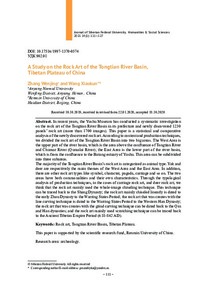Показать сокращенную информацию
A Study on the Rock Art of the Tongtian River Basin, Tibetan Plateau of China
| Автор | Wenjing, Zhang | en |
| Автор | Xiaokun, Wang | en |
| Автор | Вэньцзин, Чжан | ru_RU |
| Автор | Сяокунь, Ван | ru_RU |
| Дата внесения | 2020-12-10T03:45:11Z | |
| Дата, когда ресурс стал доступен | 2020-12-10T03:45:11Z | |
| Дата публикации | 2020-12 | |
| URI (для ссылок/цитирований) | https://elib.sfu-kras.ru/handle/2311/137766 | |
| Аннотация | In recent years, the Yushu Museum has conducted a systematic investigation on the rock art of the Tongtian River Basin in its prefecture and newly discovered 1230 panels’ rock art (more than 1700 images). This paper is a statistical and comparative analysis of the newly discovered rock art. According to content and production techniques, we divided the rock art of the Tongtian River Basin into two big areas. The West Area is the upper part of the river basin, which is the area above the confluence of Tongtian River and Chumar River (Qumalai River); the East Area is the lower part of the river basin, which is from the confluence to the Batang estuary of Yushu. This area can be subdivided into three subareas. The majority of the Tongtian River Basin’s rock art is categorized as animal type. Yak and deer are respectively the main themes of the West Area and the East Area. In addition, there are other rock art types like symbol, character, pagoda, carriage and so on. The two areas have both commonalities and their own characteristics. Through the typological analysis of production techniques, in the cases of carriage rock art, and deer rock art, we think that the rock art mainly used the whole-image chiseling technique. This technique can be traced back to the Shang Dynasty; the rock art mainly chiseled linearly is dated to the early Zhou Dynasty to the Warring States Period; the rock art that was creates with the line carving technique is dated to the Warring States Period to the Western Han Dynasty; the rock art that was creates with the grind carving technique can be dated back to the Qin and Han dynasties; and the rock art mainly used scratching technique can be traced back to the Ancient Tibetan Empire Period (618-842 AD) | en |
| Аннотация | В последние годы музей Юйшу проводил систематические исследования наскальных рисунков в бассейне реки Тунтянь в своей префектуре. Были обнаружены 1230 плит (более 1700 изображений). Данная статья представляет статистический и сравнительный анализ найденных образцов. По содержанию и технологиям нанесения наскальное искусство можно разделить этого района на две большие группы: западную – верхняя часть бассейна реки, расположенная до слияния рек Тунтянь и Чумар (река Кумалай), и восточную – нижняя часть бассейна от слияния до реки Батанг в Юйшу. Вторую область можно подразделить еще на три части. Большая часть изображений представляет собой фигурки животных. Як и олень – главные темы обеих групп. Кроме того, встречаются символы, персонажи, пагоды, повозки и проч. Обе группы, помимо общих черт, имеют и свои особенности. Типологический анализ технологий нанесения позволяет предположить, что для создания рисунков повозок и оленей в основном использовался способ долбления всего изображения (техника периода династии Шан). Наскальные рисунки, высеченные линейно, относятся ко времени от ранней династии Чжоу до периода Сражающихся царств. Техника резьбы по линиям датируется периодом Сражающихся царств времен Западной династии Хань, а техника шлифования, вероятно, временем династий Цинь и Хань. Изображения, где в основном использовалась техника царапания, восходят к периоду Древней Тибетской Империи (618–842 гг. н. э.). | ru_RU |
| Язык | en | en |
| Издатель | Сибирский федеральный университет. Siberian Federal University | en |
| Тема | Rock art | en |
| Тема | Tongtian River Basin | en |
| Тема | Tibetan Plateau | en |
| Тема | наскальное искусство | ru_RU |
| Тема | долина реки Тунтянь | ru_RU |
| Тема | Тибетское плато | ru_RU |
| Название | A Study on the Rock Art of the Tongtian River Basin, Tibetan Plateau of China | en |
| Альтернативное название | Наскальные рисунки в бассейне реки Тунтянь (Тибетское плато, Китай) | ru_RU |
| Тип | Journal Article | en |
| Контакты автора | Wenjing, Zhang: Anyang Normal University Wenfeng District, Anyang, Henan , Ch | en |
| Контакты автора | Xiaokun, Wang: Renmin University of China Haidian District, Beijing, China | en |
| Контакты автора | Вэньцзин, Чжан: Центральный университет национальностей Китай, Пекин, Хайдянь | ru_RU |
| Контакты автора | Сяокунь, Ван: Китайский народный университет Китай, Пекин, Хайдянь | ru_RU |
| Страницы | 111–127 | |
| DOI | 10.17516/1997-1370-0574 | |
| Журнал | Журнал Сибирского федерального университета. Гуманитарные науки. Journal of Siberian Federal University. Humanities & Social Sciences 2021 14(1) | en |

